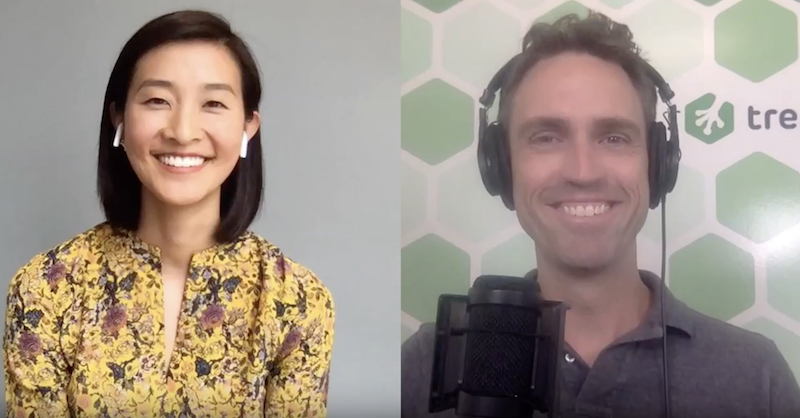As the founder of a company that’s helped 850,000 people learn to code, Ryan talks about the value of trust as a leader .
Every two weeks as part of The Heartbeat , I asks one question to a founder, CEO, or business owner I respect. This week, I interviewed Ryan Carson, Founder and CEO of Treehouse. Watch & read what he has to say here…
Claire: Hi everyone, I’m Claire Lew, and I’m the CEO of Know Your Company and I am so excited and honored to have a really special guest today on the heartbeat. I have Ryan Carson, who is the founder and CEO of Treehouse, which I’m sure if you’re like me, you’ve definitely used if you’ve tried to learn how to code or dabbled around learning to be more technical, you’ve definitely checked out Treehouse. But I’ve been a big fan of Ryan’s for a while. I believe we met at a conference a few years ago, in New York — 99U — which we both spoke at, and that was super rad. I’ve been most impressed recently with your efforts around both, just really working to help retain and build up more diverse and inclusive talent in tech. I think that’s really cool, and thanks so much for being here, Ryan.
Ryan: Thanks for having me. I’m excited to chat. I love what you’ve built, and I’m impressed with you as an entrepreneur and as a person, so it’s always fun to chat.
Claire: I will take that. Thank you. But I’m here to, well, I’m here to pick your brain though today, Ryan. I’ve got this one question that I’ve been asking leaders that I admire, and it is what’s something you wish you would have learned earlier as a leader?
Ryan: Oh boy, there is a lot. Can I have 20 answers?
Claire: Yeah, you could probably write some books about this one.
Ryan:
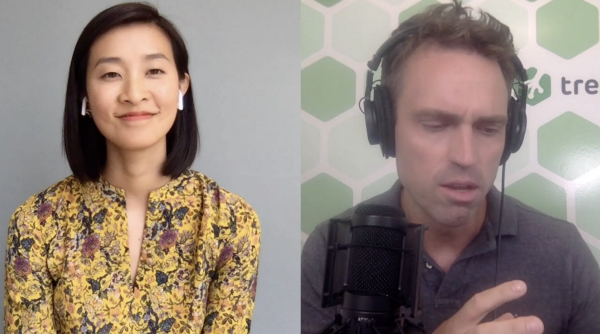
The most important thing I’ve learned is I needed to build trust, and trust unlocks the ability to be successful.
So let me explain.
I built Treehouse from scratch. It was an idea my wife and I had because we’re extremely passionate about empowering people with education. So I got a computer science degree, then I got a job, and then I realized the system was broken, and a lot of people, millions of people were getting hurt by that system. And so we thought, “Let’s change it.” So like most people, had an idea, didn’t know how to do it and just started trying, and ended up a right idea at the right time. So we grew and we had success early, and then we had many years of hardship and success, then it got interesting.
But I always thought you could just be kind of charismatic, and that’s what you needed as a leader, and it turns out that’s not true. So people kind of don’t care about charisma in their leaders, they want someone they can trust. And then as soon as you trust someone, then you can work really hard, and be really effective and be really passionate about what you do. But if you don’t have that basic level of trust, everything slows down to just like wading through molasses.
Claire: Absolutely.
Ryan: And so it kinda paid that price because I thought, “Yeah, I just need to tell everybody where we’re going and be charismatic about it and everything will work out.” And it turns out that’s not true. So trust is absolutely everything.
Claire: I love that answer because I think it is instinctive for many leaders, “Oh yeah, I need to build trust.” But what you really made a clear delineation between Ryan is trust is not the charisma.
Ryan: Yeah, it’s totally different.
Claire: Talk to me a little bit about that. Like when you, first of all, what is trust? Like how do you, how do you build it? Because if it’s different than charisma, because I think some people think, “Well, trust is being friendly.” It’s sharing hobbies with people.
Ryan: Being liked.
Claire: Exactly, it’s being liked, it’s making jokes. Isn’t that charisma? Isn’t that actually how you build trust. Tell me in your mind then, how are they different?
Ryan: Okay. So we have 80 employees now, and as we grew, what happened is, what was in my mind wasn’t being communicated to everybody in depth enough. So I knew exactly where we’re going and why we’re doing it, and so I just want to get there as fast as we could. And so it ended up kind of saying, “Do this thing,” and people are sort of going, “I don’t understand why, but I’ll do it, but I don’t understand why.” And then you start to break down their trust in you, and then it doesn’t work to just say, “We’ll do it,” because I don’t have time to explain why. And so what I learned trust is, and this basically is the Franklin Covey model. There’s a book called Speed of Trust, which I highly recommend.
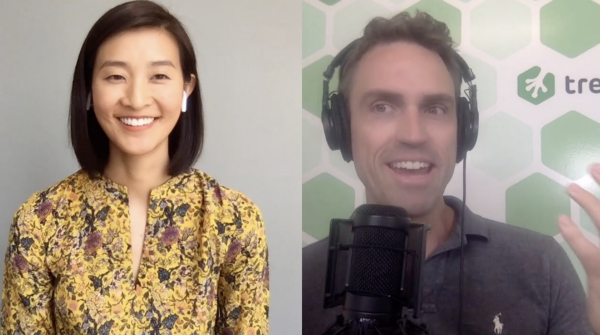
And in it turns out it’s kind of funny. It’s actually the first dysfunction of a team that’s talked about in the five major dysfunctions of a team, which I didn’t learn that until Saturday. So I was like, “Oh, I’m glad we worked on trust because it turns out to be the major dysfunction in teams.”
So it turns out trust is a tree. So imagine a tree with roots, trunk, branches and leaves. And the first part of trust is integrity. Like, do you basically believe this person has integrity? At just a core level, are they aa trustworthy person? And if you just don’t think that this person has any integrity, you’ll never be able to move beyond that. But most of the time, you’re at work, and you’re like, “I think this person has basic integrity, I don’t know them super well, but it seems like they’re a reasonably normal person.” So that’s usually pretty straightforward. If you, if people don’t think your basic integrity, you got to work on that.
Claire: Step one.
Ryan: Yeah, that’s pretty important. So once you believe someone has integrity, then you can move up the tree to the trunk. And the next, the trunk is intent. So do you understand what this person is intending to do? So not just what they’re telling you to do, but why they’re telling you to do it. So maybe you’re having a marketing session and someone says like, “I think we should launch a podcast.” And if you don’t know their intention is to change your overall goal numbers, you think that they are passionate about podcasts, and that’s why they’re saying they should do a podcast. Then you don’t understand their intention, and then you start to not be able to trust like, “Well, I don’t like podcasts, I don’t like the idea and so on,” and then your trust breaks down. It’s like, oh man. Their intent was, which is your intent is to increase your goal number. You’re on the same page. You have the same intention.
So you have to over-communicate. That’s the way you solve for that. This is what I’m intending to do, this is why I’m doing it, and it feels really painful to a leader like, “Oh my God, I have to say this again? Why are we doing this thing?” And it turns out, yeah, you do, because people can’t read your mind.
Claire: Surprise!
Ryan: Then you have to say it a lot of times because maybe you know their kid broke their leg over the weekend and they couldn’t hear that announcement, or maybe they’re going through a divorce or maybe, this is real stuff people are going through, and just because you say it in an all hands meeting, or have an email doesn’t mean they heard it. So intention. So that’s just about usually communicating clearly a lot, and saying the same thing over and over again. So you’ve got roots which is integrity, trunk, which is intention.
Once you build those two things, then you can move on to the branches, and the branches are capability. So you have to believe that someone actually has the tools to deliver results. So as a CEO, I could have integrity, people can understand my intentions, but if people say, “Ryan’s never been a CEO before,” I don’t know if he has the tools to actually be a good CEO. I don’t know if he has the capability, or the knowledge. So you actually have to have the knowledge, how to solve the problem, or demonstrate that you can get it very quickly.
So that’s usually a skill thing, that’s a training thing, that’s an experience thing, you can get all those things. So once you have capability, then ultimately, you have to deliver results, and that is the leaves of the tree. So ultimately, a tree is no good if it’s just dead bark. There actually has to be leaves on it, there has to be results. So in the end, after all this work, eventually our results achieved, and then it’s like a loop. Then you just have to keep reinforcing the tree and growing the tree, and you got to continue to have integrity. You’ve got to continue to communicate your intention. You have to continue to learn and get better, and then you have to continue to deliver results.
Claire: Absolutely.
Ryan: Over time, like no one expects you to do all that immediately.
But if you’re on that journey and you’re communicating where you’re at in the journey, then you can build real trust. And this has changed my life. I can’t express the difference in my work at Treehouse before building trust and after. It has just been a game changer.
Claire: What’s an example? Give me. I’m like, “Change your life?” That’s bold words, Ryan.
Ryan: Yeah, I mean it. So a good example is I had a new person report to me, they were reporting to somebody else, and being the CEO sometimes, reporting to the CEO can be hard on people because you have tons of power, you often will be kind of blunt. There’s kind of a style that’s typical of CEOs, and it’s hard for non-execs to report to somebody like that. And so I had done some damage to the relationship because I was too brazen about something, or I was just too kind of “Ryan”. And so when that person’s reporting to me, I said, “I want to, I want to intentionally build trust with you. I feel like maybe some of that trust broke down, and I want to be very intentional about building it back up. So, are you interested in doing that?” And they said, “Yes.” And then we started going through the behaviors of trust. So basically I said, “Okay, what behaviors are important to you to help me build trust with you?” And this book has a framework for this and again, it’s not some silver bullet, but it’s a, it’s a way to attack it.
Claire: Absolutely.
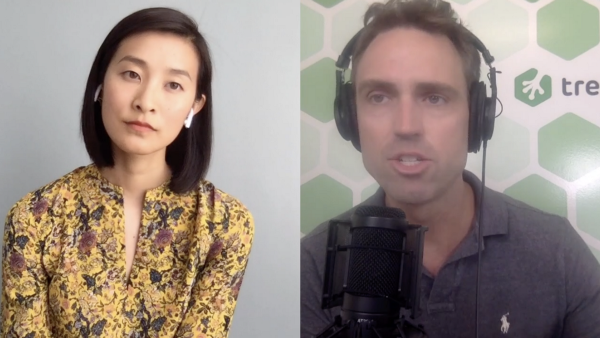
Ryan: And so the framework’s pretty straightforward. I think there’s like 13, 14 behaviors of trust, and there’s actually, it’s so cool, it’s like a playbook. If you want to build trust, exhibit behaviors one, three, eight and 10. Right. And if you want to repair trust, do behaviors two, four, 10 and 12. And so we literally pull up the cards and say, “Okay, I want to demonstrate these behaviors to you, I’m going to work on that.” And then it’s just everything becomes clear. They understand my intention. Hopefully they believe I have integrity, and then we’re building that tree again and it does take time. But actually not that long. I’ve been working with this person now for less than a month, and already we are literally on the phone this morning.
I was like, “How do you feel like we’re doing, building that trust?”, and they said, “Really good.” So I think it goes to show work relationships can be wonderful, and that doesn’t mean you have to be friends and love each other. You just have to have this trust, and then you can have an effective, really satisfying relationship.
Claire: Definitely. So many different pieces I want to ask questions about you, Ryan. The first is this framework that you talk about which is really or popularized by the Speed of Trust book. I’ve always found it fascinating because it almost divides trust into two different areas. So there’s one idea about trust being about character, so I have to believe you’re a good person, I have to believe that your motives are pure, that’s part of the intent piece. And then about competence, which is that it’s not enough for me to like you. It’s not enough for me to think you’re a good person. It’s not even enough for me to think you have my intention, that’s your heart, or the company’s intention. You actually have to be able to do good work. If you’ve delivered late on stuff, if you’ve underperformed in the past, if you’ve never been a CEO before, then maybe I’m not going to trust you as much. And so I think that, back to the question or this idea that you pointed out of trust is not charisma. It’s because it’s about, like you were saying, it’s about integrity, it’s about intent.
And then it’s also about showing that you can do the stuff, and we don’t separate that when we think about trust as leaders.
Ryan:
We throw around the word “trust”. I did for a long time without actually explaining what it means and knowing what it means. And it becomes this emotional weapon like, “I don’t trust you.”
Claire: Yes, very true.
Ryan: And that’s a terrible thing. What I found is it was effective for me to say, “I’m a new leader for you. I’m a new manager for you.” For instance, I want to build trust with you.
I don’t actually expect you to trust me just because I’m your boss. I need to earn it.
Claire: Yes. It’s earned, it’s built, exactly. I absolutely loved that. I think we take for granted that just because we are in a company, just because I have this title and you have this title, we are supposed to trust each other, and for new managers in particular, that idea that that trust needs to be built for new employees as well ,ut that’s something that needs to be cultivated I think is so, so important. Another thing that you talked about is just the difference that focusing on this has made in two ways. So in how you sort of run the company, talked about over communication. So I would love to hear a little bit more about what does that look like for an 80-person company? Very tactically, do your execs sort of hate it, like are people on board with it? And then second, on an interpersonal level of how, like you’re saying, it’s actually made this one particular working relationship a lot more pleasant and not as intimidating for this new person. Tell me about this over-communication part though first.
Ryan: Yeah, totally. So what we do is we created something called a two-year vision, and we as an executive team, we decided what is the most important thing we need to accomplish in the next two years. And then we broke it down into measurable goals. Okay, what by when? And then we laid it out in this beautiful poster, and we called it our two-year vision, and it’s completing on January 1st, 2020. So that was, “Okay, let’s get the plan straight in our head.” And then what it was is not just kind of launching it to everybody because again, that causes fear, that causes confusion. We actually just kind of start looping people in. It’s not like a back channel thing. It’s more, “If I have direct reports I’m going to start talking about in my one on ones, just want to put this under your radar.”Me and the execs are thinking about launching a two-year vision. This is the way we’re kind of thinking about it. Do you have any thoughts on that?”
And you’re getting people used to ideas, and then give them chance to get feedback, and then that flows down through the company. Like, “Okay, we’re going to launch this thing called a two-year vision,” “Yeah, I’ve kind of heard about it. I’ve talked a little bit about it to my manager.” So by the time it comes out, you’re like,” I already kind of know about this,” “Yeah, this is kinda cool.” And maybe I even said something that got kind of input into it. So that’s part of it. Over-communicate as you’re thinking about things is great, and that’s not always possible, but on a lot of things it is. And then that’s one thing. I underestimated the value of telling people to be aware that things are gonna happen. Massive value.
Claire: I have to pause on that for a second, Ryan, because I can’t tell you how many leaders that we work with and that I speak to, how many CEOs who they talk about the value of over-communication, but it’s almost like, “Here’s the plan. We’re just gonna take the script and just sort of repeat it as much as possible.” And what you’re saying is, well, no, there’s actually a step before that which is to sort of slowly get people to buy in, and it may seem like it takes more time, but you’re actually building trust by slowly unpacking and getting people’s ideas and kind of germinating the idea before it actually becomes a thing.
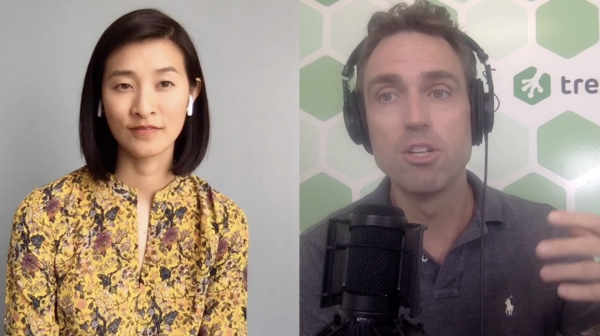
Ryan: Yes, and it does. It probably takes two more weeks to kind of roll that out and get people talking about it. But it turns out you weren’t going to do anything in two weeks anyway, like that really changed anything anyway. So actually, that’s the thing that we’re going to do in a year. In the next two weeks, not much is going to happen. That’s okay. So the kind of pre-talk is important. And then what we do now is every month, we have an all hands meeting where a distributing company, so we use Zoom for that. Se do have offices, so we have about 30 people on Portland, about 15, I think, in Orlando. Everyone else works from home around the United States. So we have a Zoom call and every month, we say, “Let’s talk about the two year vision. We’re actually going to remind you what it is.
So we go through the slides. I’m like, “Okay, our mission is this, this is the two-year vision, okay, these are the big numbers. Okay. Let’s talk about each number, how are we doing?” And then we update how we’re doing on the number. And it turns out we actually had to change some of the numbers, and everyone might think, “Oh, that’s terrible.” You should never change your numbers if you got, It’s like, “No, that’s not true because we learned some stuff and it turns out some of our numbers were wrong.” But then that was the process. Like, “Okay, how do you not freak people out when you have to change your plan?. So that was again, “Let’s tell everybody slowly,” and so at the all hands, we would say things like, “Well, here’s the chart we’ve been showing you, but actually, here’s an interesting chart that we’ve been thinking about measuring it this way. We just want to show everybody kind of how we’re thinking about it. We’re not changing the official number yet, but we just want you to know, like we’re learning some stuff.”
Claire: We’re starting to think about just different ways.
Ryan: Yeah, we’re learning and here’s what we’re learning. And everyone’s like, “Okay, we’re learning stuff.” And then we did that for two or three months. And then eventually we’re like, “Okay, we’ve been talking about this for two or three months. We’re just going to make it official now, and everyone’s like, “Great,” and it’s so crazy, Claire, there’s no drama. I was like, “Oh, there’s going to be drama.”
Claire: Yeah, I was waiting for that, Ryan. I was waiting for you to be like, “Okay, and so we did this,” And then, but you’re like, “No, no drama. It’s easy.”
Ryan: It was like, “Is there any questions?” Everyone’s like, “Not really. We get it.” I’m like, “Good, we’re over-communicating.”
Claire: Yeah, mission accomplished. I love that. So it’s like two processes of the pre-talk part that you’re saying, and then again, just about to make it seem sort of slowing it down, revealing your process, that makes so much sense. I think, go for it.
Ryan: I was just gonna say we’re not perfect either, so it sounds perfect, but I just found out in a one-on-one that I hadn’t been communicating something enough. It’s like, “Oh gosh, I thought I was, but I wasn’t.” So it’s a constant process of trying to get better.
Claire: Always, but what’s really interesting, even about that situation, is that someone told you.
Ryan: Yeah, that’s good.
Claire: That’s amazing because what happens nine times out of 10, at least with the CEOs that we talked to is that no one tells them that they should have been communicating something more. So the fact that you even have a system for someone to tell you that, I think that’s the ideal situation because yeah, we all don’t know sort of how well we’re doing on that, on those levers. So here’s my sort of last question to you here, Ryan, which is for leaders and managers and aspiring leaders who are watching this, and who are thinking, “Yes, Ryan, in your wonderful company at Treehouse, you’ve been able to build trust, but man, you don’t have my manager or you don’t work with my team, or you don’t understand what my work environment is like. I’m skeptical about this trust thing. Do you have any advice, tactics, words, wisdom, around why this stuff is important, and maybe steps that they can take to sort of build trust with their employees or their team?
Ryan: Yes, you bet. That’s a great question. I would say if you’re a manager, I’ll give two answers. One from a manager’s point of view, one for a direct.

I would say for the manager, you could always say, “Hey team, hey person I manage, I don’t know if we’ve built a lot of trust, and I just want to talk about it and I actually want to be intentional about building trust. I want to have a great working relationship with you. So here’s a process I’m thinking about going through with you. Here’s how it works, are you interested in that?”
And that would be basically running through the behaviors of trust in the Speed of Trust book. So that’s one thing, and most employers would be like, “Yeah, that sounds great.” If you are managed by a poor manager, I would start from a place where you try to have good, just believe that this person is coming from a good place. So say I’m going to choose to believe that your intentions are good ,and this is kind of part of the trust exercise. Like I’m going to start there even though I don’t know if that’s the truth.
And then sit down with them in your one-on-one if you have one-on-ones and say, “I want to build an even better relationship with you. I want to help the company achieve its goals. I know you want those things too. I’d like to be more intentional about building even more trust with you.” So you’re not going to say, “We don’t have any trust, and it’s totally terrible. I want to create trust,” as they may be like, “Oh, I hate that,” and if they’re a bad manager, they’ll fire you. So it’s about, “I want to build more trust, I want to be more effective,” kind of selling that idea, and then say, “I’m reading this book called Speed of Trust. Would you be interested reading with me?” And then you’ll probably find this person’s like, “Oh my gosh, I wasn’t trained on how to be a good manager. It’s blowing my mind,” and then they become a better manager, and then the process spreads throughout the company. So start with one person, and see if you can get it kicked off.
Claire: Absolutely, and start with the conversation and what I think is important to highlight here is start with your intent. Start with your intentions.
Ryan: Yeah. “My intention is to build more trust with you. I want that to happen.”
Claire: Exactly. It’s not about anything else. Well Ryan, thank you so much for sharing all your thoughts and experience, and reminding us what trust is, and what we need to be doing about it as leaders. So thank you.
Ryan: You’re welcome. It’s really fun to talk about. Appreciate your time.
Claire: Likewise. Talk soon. Thanks.
